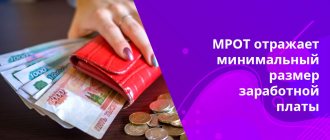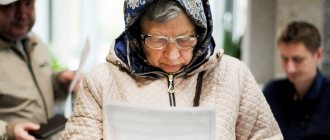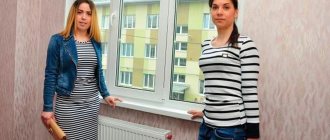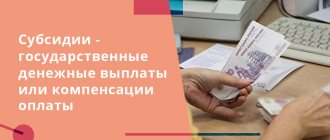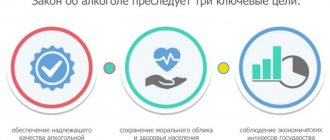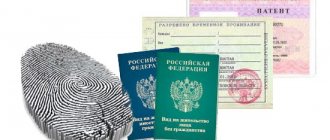Russian Prime Minister Mikhail Mishustin signed a decree establishing a new living wage and consumer basket in Russia for 2021. Starting from 2021, the cost of living (LM) for the country and regions is calculated according to new rules. The corresponding law was signed by Russian President Vladimir Putin at the end of December. Previously, the cost of living was calculated based on the consumer basket, but from 2021 it is determined as part of the average per capita income of citizens.
The minimum wage, pension and some benefits are “tied” to the minimum subsistence level. In this article we will tell you what the cost of living is set in Russia in 2021, and provide a table for all regions with the latest changes.
A new cost of living has been established in Russia for 2021
From January 1, 2021, the methods for calculating the minimum wage and the subsistence level have changed in Russia. Now their values depend not on the cost of the consumer basket, but on median income and salary. For the first time, the minimum wage (RUB 12,792) became higher than the subsistence level.
The living wage is a special calculation indicator that affects many types of social benefits in favor of employees. The subsistence allowance is the monetary expression of a person’s minimum needs for living for one calendar month. The value is reviewed annually. The current cost of living in Russia and the regions for 2021 is in the article.
What is the cost of living in Russia
The subsistence minimum is a set of minimum expenses necessary for a person to live a normal life per month. The minimum is for the Russian Federation as a whole, by region, and is also divided into a minimum for the working population, pensioners, and children.
The economic indicator includes:
- The cost of a food basket is a monthly set of food products designed for one Russian.
- Costs of paying for utilities - the amount is determined by the average calculated indicators of the cost and volume of energy consumption.
- Expenses for the purchase of essential goods include spending on medicines, personal hygiene products, and household goods.
- Expenses to pay for other household goods, works and services - we are talking about the purchase of additional services that cannot be included in the category of essential necessities, but they are also mandatory for a person’s normal life. For example, purchasing clothes and shoes, paying for hairdresser services, etc.
In simple words, the cost of living is the monetary expression of a person’s minimum needs for living for one calendar month.
What is included in the cost of living indicator:
- The cost of a conventional food basket, which includes basic food products for one Russian citizen for a month.
- Expenses for basic goods: medicines, personal care products, and household products.
- Payment of utility bills.
- Funds spent on the purchase of any household goods, fees for various works and additional services that are not included in the group of vital needs. In general, everything that is important for the normal existence of people: buying clothes and shoes, using medical and educational services, renting living space, paying for travel, etc.
Consequently, the cost of living reflects in monetary terms the system of basic needs of people for a normal existence for one month.
New federal cost of living in the Russian Federation in 2021
Government Decree No. 2406 dated December 31, 2020 established the living wage for 2021 in Russia as a whole.
Current values for 2021 by population category:
- per capita 11,653 rubles
- for the working population – 12,702 rubles
- for pensioners – 10,022 rubles
- for children – 11,303 rubles
According to Federal Law No. 473-FZ of December 29, 2021, the cost of living per capita in the Russian Federation as a whole for the next year is established by the Government of the Russian Federation, taking into account the opinion of the Russian Tripartite Commission for the Regulation of Social and Labor Relations and is calculated based on the median per capita income for the previous year.
The ratio of the cost of living per capita in the Russian Federation as a whole and the median per capita income for the previous year is set at 44.2 percent from 2021.
For 2021, the cost of living per capita and for the main socio-demographic groups of the population in the subject of the Russian Federation is established by the subject of the Russian Federation in an amount not lower than the cost of living per capita and for the main socio-demographic groups of the population in the subject of the Russian Federation for the second quarter 2021.
Table of the cost of living in Russia by quarter
| Period | Amount in rubles/month. | Official document | |||
| Per capita | For the working population | For pensioners | For children | ||
| From 01/01/2021 | 11653 | 12702 | 10022 | 11303 | Decree of the Government of the Russian Federation No. 2406 of December 31, 2020 |
| IV quarter 2020 | 11329 | 12273 | 9348 | 11140 | No. 542n dated March 16, 2021 |
| III quarter 2020 | 11606 | 12542 | 9519 | 11580 | No. 987n dated 12/31/2020 |
| II quarter 2020 | 11468 | 12392 | 9422 | 11423 | No. 542n dated 08/28/2020 |
| I quarter 2020 | 10843 | 11731 | 8944 | 10721 | No. 372n dated June 25, 2020 |
| IV quarter 2019 | 10609 | 11510 | 8788 | 10383 | No. 72n dated 02/20/2020 |
| III quarter 2019 | 11012 | 11942 | 9090 | 10838 | No. 738n dated November 25, 2019 |
| II quarter 2019 | 11185 | 12130 | 9236 | 11004 | No. 561n dated 08/09/2019 |
| I quarter 2019 | 10753 | 11653 | 8894 | 10585 | No. 461n dated 07/02/2019 |
| IV quarter 2018 | 10213 | 11069 | 8464 | 9950 | No. 102n dated 02/20/2019 |
| III quarter 2018 | 10451 | 11310 | 8615 | 10302 | No. 695n dated 11/12/2018 |
| II quarter 2018 | 10444 | 11280 | 8583 | 10390 | No. 550n dated 08/24/2018 |
| I quarter 2018 | 10038 | 10842 | 8269 | 9959 | No. 410n dated June 25, 2018 |
| IV quarter 2017 | 9786 | 10573 | 8078 | 9603 | No. 232n dated 04/13/2018 |
| III quarter 2017 | 10328 | 11160 | 8496 | 10181 | No. 1490 from 08.12.2017 |
| II quarter 2017 | 10329 | 11163 | 8506 | 10160 | No. 1119 from 09/19/2017 |
| I quarter 2017 | 9909 | 10701 | 8178 | 9756 | No. 730 from 06/20/2017 |
| IV quarter 2016 | 9691 | 10466 | 8000 | 9434 | No. 352 dated March 30, 2017 |
| III quarter 2016 | 9889 | 10678 | 8136 | 9668 | No. 1275 dated 12/01/2016 |
| II quarter 2016 | 9956 | 10722 | 8163 | 9861 | No. 882 of 09/06/2016 |
| I quarter 2016 | 9776 | 10524 | 8025 | 9677 | No. 511 from 06/09/2016 |
| IV quarter 2015 | 9452 | 10187 | 7781 | 9197 | No. 178 from 03/10/2016 |
| III quarter 2015 | 9673 | 10436 | 7951 | 9396 | No. 1291 of November 30, 2015 |
| II quarter 2015 | 10017 | 10792 | 8210 | 9806 | No. 902 from 08/28/2015 |
| I quarter 2015 | 9662 | 10404 | 7916 | 9489 | No. 545 of 06/04/2015 |
| IV quarter 2014 | 8234 | 8885 | 6785 | 7899 | No. 260 from 03/21/2015 |
| III quarter 2014 | 8086 | 8731 | 6656 | 7738 | No. 1321 from 05.12.2014 |
| II quarter 2014 | 8192 | 8834 | 6717 | 7920 | No. 905 of 09/06/2014 |
| I quarter 2014 | 7688 | 8283 | 6308 | 7452 | No. 586 of June 26, 2014 |
Attention! From January 1, 2021, the model for establishing the cost of living is changing. Now, in the Russian Federation as a whole, it will be installed annually. This agreement was reached at a joint meeting of the State Council and the Council for Strategic Development and National Projects.
A new way to calculate the cost of living in 2021
The actual cost of living changes constantly; this is influenced by inflation, price dynamics, the political situation and much more.
Previously, the calculated indicator was established on the basis of complex economic calculations and calculations. But now the cost of living for the next year is approved not quarterly, but once a year.
If previously its value was determined based on calculating the cost of products included in the consumer basket, now it depends on the median per capita income in the country.
How the cost of living will be calculated in 2021
Federal cost of living
The value of this economic indicator is influenced by a large number of factors: price changes, inflation, government policy, so it is constantly changing. Federal Law No. 473-FZ, adopted on December 29, 2021 , approves the cost of living established by the Government of the Russian Federation for 2021 based on statistical data obtained in the second quarter of last year. In this case, the decision of the Russian Tripartite Commission for the Regulation of Social and Labor Relations is taken into account.
In 2021, the Russian Ministry of Labor decided to use a different method for calculating the cost of living. Previously, in order to determine the cost of living, it was necessary to make various economic calculations and calculations. However, with the adoption of the aforementioned resolution, this indicator is not set every quarter, but only once for the entire year .
Previously, the value of the economic indicator depended on the total price of a basic set of goods, but now it is determined in accordance with the average level of per capita income in the country . The reason was that the cost of the consumer basket no longer reflected the real state of income and expenses of Russians.
Living wage by region in 2021
Each region of Russia has the right to independently set its own subsistence level. However, at the same time, the cost of living established by the authorities of the constituent entities should not fall below the level of this indicator in the second quarter of last year.
However, the difference between the federal and regional subsistence levels will remain in 2021. This is due to the fact that the cost of living varies across regions. Therefore, special coefficients (increasing and decreasing) for regions will be developed. Over time, the values for all regions of the country should level out.
However, to overcome the consequences of the coronavirus crisis, regions are allowed to freeze the subsistence minimum at the level of the second quarter of 2020.
| Region | Value, rub./month. | NPA | |||
| Per capita | Working population | Pensioners | Children | ||
| Adygea rep. | 9779 | 10404 | 7981 | 10060 | No. 165 from 08/27/2020 |
| Altai rep. | 10761 | 11155 | 8903 | 10801 | No. 281 from 08/25/2020 |
| Altai region | 10460 | 11190 | 8960 | 10611 | No. 382 from 04.09.2020 |
| Amur region | 12950 | 13752 | 10491 | 13547 | No. 195 from 08/05/2020 |
| Arkhangelsk region | 13802 | 15026 | 11427 | 13744 | No. 463-pp dated 08/03/2020 |
| Astrakhan region | 10845 | 11336 | 9021 | 11722 | No. 329-P dated July 29, 2020 |
| Bashkortostan rep. | 10015 | 10641 | 8155 | 10077 | No. 553 from 09/08/2020 |
| Belgorod region | 9382 | 10265 | 8204 | 9364 | No. 385-pp dated 08/24/2020 |
| Bryansk region | 11280 | 12085 | 9319 | 11206 | No. 297-p dated July 20, 2020 |
| Buryatia rep. | 12341 | 12810 | 9734 | 12968 | No. 487 from 08/14/2020 |
| Vladimir region | 11093 | 12085 | 9303 | 11294 | No. 468 from 07/29/2020 |
| Volgograd region | 10158 | 10892 | 8204 | 10414 | No. 480-p dated 08/14/2020 |
| Vologda region | 11767 | 12761 | 9707 | 11732 | No. 929 from 08/10/2020 |
| Voronezh region | 9362 | 10139 | 7821 | 9375 | No. 863 from 09/15/2020 |
| Dagestan rep. | 10462 | 10717 | 8200 | 10757 | No. 190 from 01.09.2020 |
| Jewish Autonomous Region | 15733 | 16717 | 12713 | 16479 | No. 129/20 dated 07/13/2020 |
| Transbaikal region | 13397 | 13909 | 10561 | 14199 | No. 319 from 08/10/2020 |
| Ivanovo region | 10761 | 11696 | 8971 | 10877 | No. 102-ug from 07/24/2020 |
| Ingushetia rep. | 10571 | 10601 | 8282 | 11015 | No. 93 from 07.24.2020 |
| Irkutsk region | 12243 | 13012 | 9881 | 12759 | No. 625-pp dated 07/30/2020 |
| Kabardino-Balkarian Republic | 12576 | 12998 | 9679 | 13815 | No. 170-PP dated 08/17/2020 |
| Kaliningrad region | 11706 | 12563 | 9566 | 11304 | No. 575 from 08/17/2020 |
| Kalmykia rep. | 10631 | 11083 | 8473 | 10926 | No. 245 from 07/24/2020 |
| Kaluga region | 11400 | 12254 | 9410 | 11333 | No. 663 from 08/28/2020 |
| Kamchatka Krai | 21176 | 22232 | 16780 | 22693 | No. 284-P from 07/16/2020 |
| Karachay-Cherkess Republic | 10424 | 10950 | 8382 | 10840 | No. 174 from 08/13/2020 |
| Karelia rep. | 14391 | 15627 | 12025 | 13713 | No. 456-P dated 09/08/2020 |
| Kemerovo region. | 10727 | 11354 | 8624 | 11254 | No. 490 from 08/13/2020 |
| Kirov region | 10666 | 11395 | 8678 | 10954 | No. 430-P from 06.08.2020 |
| Komi Rep. | 14424 | 15568 | 11806 | 14492 | No. 377 from 07/28/2020 |
| Kostroma region | 10929 | 11928 | 9159 | 10900 | No. 339-a dated 08/03/2020 |
| Krasnodar region | 11397 | 12298 | 9375 | 11114 | No. 1237 from 02.09.2020 |
| Krasnoyarsk region | 13149 | 13919 | 10248 | 13763 | No. 499-p from 07/14/2020 |
| Crimea rep. | 10998 | 11753 | 8971 | 11682 | No. 447 from 08/04/2020 |
| Kurgan region | 10483 | 11190 | 8676 | 11027 | No. 254 from 08/20/2020 |
| Kursk region | 10459 | 11206 | 8655 | 10627 | No. 757-pa dated July 27, 2020 |
| Leningrad region. | 11137 | 12067 | 9495 | 10718 | No. 615 from 09/07/2020 |
| Lipetsk region | 9945 | 10742 | 8312 | 10215 | No. 437 from 07/29/2020 |
| Magadan region | 20588 | 21767 | 16309 | 21880 | No. 124 dated July 20, 2020 |
| Mari El rep. | 10067 | 10735 | 8222 | 10415 | No. 292 from 07/28/2020 |
| Mordovia rep. | 9378 | 10079 | 7693 | 9796 | No. 420 from 07/23/2020 |
| Moscow | 17841 | 20361 | 12606 | 15450 | No. 1351-PP dated 08/25/2020 |
| Moscow region | 13509 | 14941 | 10103 | 13317 | No. 673/30 dated 09/23/2020 |
| Murmansk region | 17909 | 18645 | 14858 | 17933 | No. 565-PP dated 08/07/2020 |
| Nenets Autonomous Okrug | 22049 | 23278 | 18001 | 22884 | No. 196-p dated 07/21/2020 |
| Nizhny Novgorod region. | 10686 | 11540 | 8842 | 11031 | No. 624 from 07/24/2020 |
| Novgorod region | 11408 | 12378 | 9447 | 11380 | No. 223-rg dated July 15, 2020 |
| Novosibirsk region | 12284 | 13054 | 9823 | 12729 | No. 125 from 07/22/2020 |
| Omsk region | 10495 | 11101 | 8412 | 10870 | No. 310-p dated 08/19/2020 |
| Orenburg region | 9856 | 10515 | 8137 | 10289 | No. 632-pp dated 07/28/2020 |
| Oryol region | 10722 | 11480 | 8872 | 10851 | No. 478 from 07/24/2020 |
| Penza region | 9610 | 10396 | 7953 | 10002 | No. 531-PP dated 08/12/2020 |
| Perm region | 10844 | 11633 | 8914 | 11124 | No. 595-p dated 08/12/2020 |
| Primorsky Krai | 13963 | 14779 | 11224 | 15409 | No. 660-pp dated 07/31/2020 |
| Pskov region | 11624 | 12593 | 9568 | 11542 | No. 260 from 07/24/2020 |
| Rostov region | 11053 | 11753 | 8915 | 11642 | No. 691 from 08/03/2020 |
| Ryazan region | 10660 | 11506 | 8832 | 10734 | No. 33 from 07/21/2020 |
| Samara region | 10979 | 12126 | 8751 | 11000 | No. 562 from 06.08.2020 |
| St. Petersburg | 11658 | 12797 | 9458,1 | 11366 | No. 687 from 09.09.2020 |
| Saratov region | 9844 | 10615 | 8132 | 10191 | No. 689-P dated 08/14/2020 |
| Sakha (Yakutia) rep. | 17721 | 18728 | 14215 | 18559 | No. 261 from 08/20/2020 |
| Sakhalin region | 15906 | 16932 | 12757 | 17300 | No. 378 from 08/13/2020 |
| Sverdlovsk region. | 10990 | 11713 | 8962 | 11696 | No. 492-PP dated July 23, 2020 |
| Sevastopol | 11380 | 12164 | 9275 | 12276 | No. 431-PP dated 08/21/2020 |
| North Ossetia-Alania rep. | 10047 | 10599 | 8045 | 10470 | No. 272 from 08/14/2020 |
| Smolensk region | 11201 | 12038 | 9283 | 10975 | No. 468 from 07/29/2020 |
| Stavropol region | 10081 | 10749 | 8162 | 10621 | No. 428-p dated 08/12/2020 |
| Tambov region | 10221 | 11004 | 8740 | 10100 | No. 608 from 08/03/2020 |
| Tatarstan rep. | 9668 | 10294 | 7889 | 9713 | No. 637 from 07/30/2020 |
| Tver region | 11234 | 12144 | 9251,8 | 11894 | No. 350-pp dated 08/06/2020 |
| Tomsk region | 12218 | 12959 | 9815 | 12927 | No. 165-r dated 08/04/2020 |
| Tula region | 11134 | 11922 | 9384 | 11032 | No. 518 of 09/03/2020 |
| Tyva rep. | 11253 | 11634 | 8881 | 11902 | No. 396 from 08/26/2020 |
| Tyumen region | 11593 | 12196 | 9238 | 11956 | No. 531-p dated 08/18/2020 |
| Udmurt Republic | 10384 | 10995 | 8415 | 10518 | No. 371 from 08/14/2020 |
| Ulyanovsk region | 10642 | 11417 | 8716 | 10917 | No. 495-P dated 02.09.2020 |
| Khabarovsk region | 15320 | 16246 | 12314 | 16372 | No. 90 from 08/24/2020 |
| Khakassia rep. | 11772 | 12399 | 9395 | 12507 | No. 416 from 08/04/2020 |
| Khanty-Mansi Autonomous Okrug - Yugra | 16281 | 17500 | 13236 | 16306 | No. 305-p dated July 24, 2020 |
| Chelyabinsk region | 11228 | 12032 | 9288 | 11694 | No. 199 from 08/05/2020 |
| Chechen Republic | 11190 | 11563 | 9176 | 11168 | No. 224 from 02.09.2020 |
| Chuvash Republic | 9763 | 10361 | 7939 | 9851 | No. 449 from 08/12/2020 |
| Chukotka Autonomous Okrug | 22188 | 22798 | 17063 | 22982 | No. 350 from 07/24/2020 |
| Yamalo-Nenets Autonomous Okrug | 16759 | 17511 | 13191 | 16753 | No. 927-P dated July 30, 2020 |
| Yaroslavl region | 10742 | 11749 | 8689 | 10870 | No. 193 from 07/24/2020 |
By age category
Citizens of Russia are grouped by age categories, representatives of each of which correspond to an established minimum subsistence level. Due to the fact that the amounts differ for each population group, a percentage was introduced:
- 109% of the federal minimum – for those able to work,
- 97% for children and 86% for people of retirement age.
So, in 2021 :
- payments in the amount of 11,303 rubles ,
- the working-age population can count on an amount of 12,702 rubles ,
- and elderly Russians are assigned 10,022 rubles .
Living wage and minimum wage
The minimum wage is the minimum wage. The indicator is directly related to the cost of living. So, part 5 of Art. 75 of the Constitution of the Russian Federation, Part 1, Art. 133 of the Labor Code of the Russian Federation and Federal Law No. 82-FZ dated June 19, 2000, it is established that from January 1, 2021, the minimum wage in Russia cannot be lower than the subsistence level for the working population.
What does equality of indicators give? This is a personal guarantee for the working population that their wages will not be lower than the cost of the minimum needs for a normal life. That is, income, in the form of the minimum wage, cannot be lower than the established need for vital goods, works and services.
This equality has been achieved by the Government of the Russian Federation for several years, and only by the beginning of 2021 the values became equal. At that time, the values reached the amount of 11,280 rubles per month.
In 2021, the minimum wage exceeded the subsistence level for the first time, amounting to 12,792 rubles. In some regions the minimum wage is higher than this figure.
See the minimum wage in 2021 by region of the Russian Federation.
What is the living wage for?
In addition to the tasks of statistical accounting, the subsistence level indicator in the Russian Federation is used for:
- social policy planning;
- assessing the effectiveness of various programs for social security of the population;
- justification of the minimum wage;
- setting the amount of student scholarships, benefits and other social payments;
- to determine the need for social assistance;
- analysis of the standard of living of various demographic groups;
- planning and accounting of budgets of constituent entities of the Russian Federation;
- providing information to employment centers;
- regulation of the minimum wage (the minimum wage must reach the subsistence level).
New methodology for calculating the minimum wage
12,392 rubles
— The previously planned federal minimum wage for 2021, calculated by calculation in accordance with the old methodology approved by order of the Ministry of Labor of the Russian Federation (Orders of the Ministry of Labor of Russia dated 08/09/2019 N 561 n, dated 08/28/2020 N 542 n)
12,792 rubles
-New federal minimum wage for 2021, established in accordance with the new calculation methodology proposed by the Government of the Russian Federation
The new calculation method allows you to bring the PM value as close as possible to reality.
The employer must increase the salary to the new minimum wage, otherwise he cannot avoid fines. Starting from 2021, the minimum wage is calculated using a completely different methodology. Now it depends on the concept of “median salary”, previously unknown to many.
What does the cost of living influence?
The cost of living is the most important economic indicator, which is the basis for the distribution of state social assistance to the population. We are talking about social benefits, pensions, additional payments and payments for children.
In addition to state support for citizens, PM influences various spheres of Russians’ lives. For example, the amount of salary for civil servants is also set depending on the PM. The amount of penalties for causing harm to life and health is also calculated according to the PM. Even alimony for the maintenance of minor children and incapacitated dependents is determined according to the subsistence level.
Self-study documents
Moscow City Law No. 23 “On the cost of living in the city of Moscow” (09/18/2013)
Federal Law N 178-FZ “On State Social Assistance” (06/11/2021)
Federal Law No. 44-FZ “On the procedure for recording income and calculating the average per capita income of a family and the income of a citizen living alone for recognizing them as low-income and providing them with state social assistance” (04/24/2020)
Decree of the Government of the Russian Federation N 512 “On the list of types of income taken into account when calculating the average per capita family income and the income of a citizen living alone to provide them with state social assistance” (09.11.2021)
Federal Law N 134-FZ “On the subsistence minimum in the Russian Federation” (December 29, 2020)
Did you find this information useful?
0 0
What is a consumer basket
In Russia, it is an approximately calculated set of goods, reflecting the consumption structure of each individual average Russian family. It is one of the most important indicators for calculations made by statistical departments and expert councils under power structures - governments and parliaments at various levels.
From the point of view of sociology and social policy, there is another definition of the consumer basket. According to this definition, the basket includes a set of products necessary for every person for normal life. Its size gives a clear idea of the real costs of each individual citizen. Unlike abstract and abstract statistical studies, this tool gives a real idea of the minimum budget of a Russian for each year. Thus, the cost of living and the consumer basket are strongly linked.
Differences from subsistence level
The consumer basket in the Russian Federation, although it is an indicator of the well-being of the population close in value to the subsistence minimum, is far from identical. The subsistence minimum is expressed in monetary terms and determines a certain amount required by a person to satisfy his life needs. This, in addition to a set of products, includes various non-food products, as well as necessary services.
Thus, the minimum consumer basket is included in the broader concept of “living wage”. Along with purely physiological needs for food, this also includes the cost of clothing, utilities, public transport, socio-cultural benefits, etc. The cost of living is calculated as the total of all expenses on products, services and essential goods. Accordingly, the food basket, even being an important component for determining the living standard of the population, by itself, in isolation from other components, cannot act as a self-sufficient socio-economic indicator.
Calculating the cost of the consumer basket, in combination with other factors, allows us to establish:
- The minimum amount of income required for a citizen to live in the Russian Federation.
- Changing social and economic trends for better or worse.
- Determine the minimum acceptable level of subsistence level, establish the necessary amounts of social benefits.
- Compare the real cost of living in different regions of the country.
- Obtain comparative data with the socio-economic situation in other countries.
What is a living wage?
The minimum living wage is established throughout Russia and in each region by the government on the basis of Federal Law No. 134-FZ of October 24, 1997. It is necessary to determine human needs for products and other things to ensure a minimum standard of living.
It is curious that this value is never calculated in advance; on the contrary, it always appears late: for example, the cost of living in Moscow in 2021 was fully calculated only at the end of February and has not yet been finally approved. This is due to the fact that this value consists of:
- the real average cost of a food basket needed by a person for normal life;
- prices of non-food products necessary for a normal life (clothing, shoes, household chemicals)
- real cost of utilities;
- average cost of related services (travel on public transport, government services, etc.).
The algorithm for calculating the consumer basket and related services is prescribed in Law No. 134-FZ. Since the needs of different age categories of citizens are different, officials calculate the cost of living as a whole per capita, and then specify it for an adult able-bodied person, for a child, for a pensioner. In the regions, the cost of living may differ significantly from the federal one. This is due to logistical problems, prices and living standards.
A living wage is needed to assess the standard of living of the population of the Russian Federation as a whole and by region, determine the amount of social benefits, and classify citizens as those in need of support and low-income. In accordance with the requirements of Article 133 of the Labor Code of the Russian Federation, the minimum wage (minimum wage) cannot be lower than the established subsistence level. Until this year, this requirement was not observed. Even from January 1, 2021, the minimum wage in Russia is set at 85% of the subsistence level, its current value is 9,489 rubles. From May 1, 2021, it will be equal to the cost of living for the 2nd quarter of 2021 and will be 11,163 rubles. The State Duma and the Federation Council have already voted for this.
Legislative standards
Since the correct calculation of the cost of the minimum food package directly affects a number of statistical indicators, it is carried out by specialists from Rosstat. The cost is recalculated quarterly, taking into account real changes in prices for consumer goods over the past period.
The first law on the consumer basket was adopted in 2006 - Federal Law No. 44. Previously, starting from 1992, the cost of living for residents of Russia was calculated in accordance with the methodological recommendations of the Ministry of Labor and Social Protection.
In 2012, legislation No. 44 was automatically repealed due to the entry into force of the Federal Law on the consumer basket No. 227. This law regulated the principles for calculating its cost and configuration. It also contains a list of basic products necessary for normal human life. In Art. No. 2 of Federal Law No. 227 indicates the amount of consumption in kilograms per person of different ages.
Composition and structure for citizens of different ages
The composition of the consumer basket for 2021 is still regulated by the provisions established by Law No. 227. Previously, it was planned to review the food package every five years. But over the past seven years, no changes have occurred regarding the structure and composition of the consumer basket. In December 2021, Federal Law No. 421 was adopted, according to which the next revision of the list of products and the number of consumption standards should occur no earlier than December 31, 2020. This is due, first of all, to the internal economic problems that began in 2014. Consequently, in 2021 the composition of the consumer basket will remain unchanged.
For adults, children and pensioners, the minimum annual consumption of essential products is:
Product name /Consumption by adults /Pensioners Children
- Bakery, pasta and cereals 126 kg /98 kg /77 kg
- Potatoes 100 kg /80 kg /88 kg
- Vegetables 114 kg /98 kg /112 kg
- Fruits 60 kg /45 kg /118 kg
- Sugar and confectionery 23 kg / 21 kg / 21 kg
- Meat 58 kg /54 kg /44 kg
- Fish 18 kg /16 kg /18 kg
- Dairy products 290 kg /257 kg /360 kg
- Eggs 210 pcs. /200 pcs. /201 pcs.
- Oils and fats 11 kg /10 kg /5 kg
- Tea and spices 5 kg / 4 kg / 3 kg
As you can see, the consumer basket in Russia for 2021 is different for different categories of citizens. This differentiation occurs due to the different needs of people of different ages in certain product groups. For example, as can be seen from the table, the minimum consumption of fruit and milk by children is much higher than that of working people or pensioners. Working-age citizens, on the contrary, consume more flour products, cereals and meat.
But these calculations, made in 2012 by Rosstat experts, do not at all coincide with the size of the minimum consumer basket in Russia, calculated by medical specialists. These data are shown in the table below, and for clarity, the average level of food consumption in the Soviet Union in the mid-1980s is shown nearby.
Product name /Minimum consumption for adults in 2021 /Standards of the Ministry of Health /Consumption norm in the USSR
- Bakery products and cereals /126 kg /96 kg /110 kg
- Potatoes /100 kg /90 kg /105 kg
- Vegetables /114 kg /140 kg /146 kg
- Fruits /60 kg /100 kg /80 kg
- Sugar /23 kg /24 kg /38 kg
- Meat /58 kg /73 kg /84 kg
- Fish /18 kg /22 kg /20 kg
- Dairy products /290 kg /325 kg /380 kg
- Eggs /210 pcs. /260 pcs. /280 pcs.
- Oil and fats /11 kg /12 kg /13 kg
- Tea and spices /5 kg /4 kg /5 kg
As you can see, Rosstat’s consumer basket is somewhat different from that recommended by the Ministry of Health for the rational nutrition of a working person. It only characterizes the possibility of living in conditions of austerity with a minimum acceptable income.
Cost of the consumer basket
The main statistical indicator, in addition to the structural composition, is the cost of the consumer basket. Based on these indicators, the cost of living for Russians is calculated. And starting from the past year, 2021, the minimum wage level established by the government of the Russian Federation depends on the price size of the food package. This is due to the linking of the subsistence level to the minimum wage, which should be a 1 to 1 ratio.
Calculation of the monetary value of the food set is initially carried out by employees of territorial statistical departments. Since the cost of products in different federal districts differs significantly, the cost of the consumer basket in 2021 will be different, despite the same nomenclature list. The controversial point is that the monetary value is calculated by Rosstat based on the minimum food price for each region. Meanwhile, the real cost of the food package may be slightly higher than the prices presented by the statistical office.
The price of the consumer basket for 2021 in federal districts looks like this:
- North-West – 11.7 thousand rubles.
- Central Federal District - 8.2 thousand rubles.
- Southern Federal District – 8.5 thousand rubles.
- Northern Caucasus – 8.4 thousand rubles.
- Volga region - 8.5 thousand rubles.
- Ural - 9.7 thousand rubles.
- Siberia – 9.3 thousand rubles.
- Far East – 10.2 thousand rubles.
- St. Petersburg – 10 thousand rubles.
- Moscow – 14.4 thousand rubles.
Based on these regional data, Rosstat calculates the average Russian price indicators of the population's food basket. The size of the 2021 consumer basket for different groups of Russian citizens in monetary terms is:
- Adults of working age – 10,800 rubles.
- Pensioners – 8,200 rub.
- Children – 9,900 rub.
The average monthly cost of a minimum food basket is calculated by simply dividing the annual amount by 12 (the number of months in a year). In the same way, the price of the daily basket is calculated for each category of the population. The cost of a food package directly affects the calculation of the population’s consumption of non-food goods and services. Thus, the annualized price of consumer goods should be equal to ½ the amount of the food basket. Also, 50% of its cost is the average person’s spending on various services - utility bills, public transport, etc.

